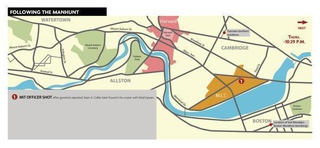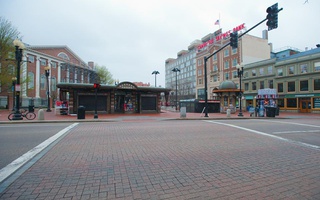As a fatal shooting at MIT and the ensuing police chase created a sense of chaos in and around Cambridge, students said that infrequent communications from University administration left them worried and in the dark as a frightening situation developed nearby.
The Cambridge Police Department received a call about shots being fired on MIT’s campus around 10:20 p.m. Thursday night. MIT’s alert system issued its first bulletin outlining the developing situation at 10:48 p.m., with 10 more to follow informing students that police were investigating the shooting and telling them to stay indoors. MessageMe—Harvard’s opt-in emergency alert system—sent its first message to students at 11:33 p.m., and as of press time had sent seven more over the next five hours.
Meanwhile, through various news outlets, Twitter, House and club lists, and even police scanners, students followed a turbulent series of events—a manhunt for two men who robbed a convenience store, killed an MIT police officer, hijacked a Mercedes SUV, and led authorities on a chase into Watertown.
At 5 a.m., Dean of the College Evelynn M. Hammonds wrote in an email to students that “the campus remains on high alert” as a precaution due to the manhunt in nearby Watertown.
“The events of this week—from the tragic Boston Marathon bombings to the shootings and police activity at MIT and Watertown overnight—have understandably created a great deal of anxiety throughout our community,” Hammonds wrote. “At this time, and in light of the most recent information about an armed and dangerous suspect in Watertown, we ask that everyone remain alert and avoid the Watertown area.”
Several hours before Hammonds sent her email, Undergraduate Council president Tara Raghuveer ‘14 said that she was “extraordinarily disappointed” that the University had not communicated with students sooner and more frequently about the events in East Cambridge and in Watertown.
“We went for a whole hour without hearing anything,” Raghuveer said. “I find it really unsettling as a student, and find it really uncomfortable as a student leader, because I think people are looking to me as a source of information.”
She said she thinks it is the duty of Harvard’s administration to reassure students and instruct them on how to stay safe, especially during a situation like Thursday evening’s when an influx of information from social media and email made it difficult to discern which sources were credible.
“I think this type of circumstance is prone to causing panic,” she said.
Her criticism of the administration came just days after students raised similar criticisms over the slow pace of the University’s communication with students following the bombing at the Boston Marathon Monday.
At 2:10 a.m., Raghuveer emailed students from the UC President’s account advising them to “stay inside, stay calm, and check on friends to make sure they are doing the same.”
House administrators took to their emails to offer their own advice to their students in the midst of the confusion.
Resident deans and House Masters from Pforzheimer, Cabot, Leverett, Lowell, Winthrop, and Eliot Houses emailed residents asking them to stay inside and remain alert.
Faculty of Arts and Sciences spokesperson Jeff Neal wrote in a statement that Harvard had been closely monitoring the situation throughout the night.
“College and University officials have been in close contact with Harvard University Police Department (HUPD) since the shooting at MIT was reported late Thursday evening. HUPD was similarly in close contact with police at MIT and with the Cambridge Police Department,” Neal wrote. “At no time was a threat to Harvard’s campus identified. However, HUPD maintained a heightened security presence on campus as a precautionary measure.”
Read more in College News
"Living Compassion" Conversation Discusses Altruism in Everyday LifeRecommended Articles
-
Police Arrest Robbery SuspectOfficers arrested a suspect early yesterday morning in connection with a series of armed robberies in the Harvard and MIT areas, relying on the joint efforts of seven police departments and the U.S. Secret Service, according to an alert from the Cambridge Police Department.
-
Candidates Edge Into State Senate RaceState Representative Jonathan Hecht of Watertown and State Representative William N. Brownsberger '78 may face off in the Senate race.
-
University To Sell Arsenal on the CharlesThe Arsenal on the Charles in Watertown has enjoyed a storied existence since its founding in 1816. Next year, it will move on to the next chapter of its existence as the headquarters of electronic health records company athenahealth, Inc., which will buy the 29-acre property from Harvard for $168.5 million.
-
 After Fatal MIT Shooting, A Police Chase and Chaos in Cambridge
After Fatal MIT Shooting, A Police Chase and Chaos in Cambridge -
Marathon Bombing Suspect in Custody
-
 University Closes With Marathon Bombing Suspect Still At-Large
University Closes With Marathon Bombing Suspect Still At-Large













